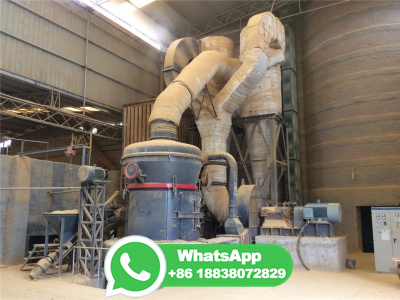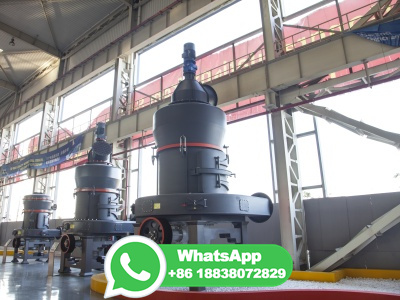
the USA at the same time: the Exxon Donor Solvent (EDS) process and the HCoal process. The distinguishing feature of the EDS process was a separate solvent hydrogenation step to carefully control the hydrogen donor characteristics of the solvent, and the most important feature of the HCoal process was its use of an ebullated bed reactor.
WhatsApp: +86 18203695377
A key feature of the Hcoal process is the use of an ebullated bed for achieving good mixing between slurried coal, hydrogen, and extruded catalyst particles. The Hcoal reactor can be modeled as a fourphase fluid bed system containing liquid, fines, gases, and catalyst particles. In order to study the hydrodynamic behavior of this gas/slurry ...
WhatsApp: +86 18203695377
The coal conversion process to be used is the HCOAL process, which is in the pilot plant testing stage under the auspices of the US Department of Energy at the HCOAL Pilot Plant Project near Catlettsburg, Kentucky. The preliminary plans for the commercial plant are for a 18,140 metric ton/day (24,000 ton/day) nominal coal assumption capacity ...
WhatsApp: +86 18203695377
reaction of coal at high pressures and temperatures with hydrogen (H2) in the presence of solvents and catalysts, yielding synthetic crude oil that can be refined into liquid fuels. onsidering the great extent and distribution of domestic coal reserves in the United States
WhatsApp: +86 18203695377
This document contains the final results of an investigation to determine the suitability of the COED, HCOAL, SYNTHOIL, and SRC II syncrudes as petrochemical feedstocks. Based on the results of laboratory investigations, conversions of the liquid products to petrochemical feedstocks per ton of coal fed to each liquefaction process was % ...
WhatsApp: +86 18203695377
The objective of this work was to evaluate the applicability of commercial UOP hydrotreating and reforming processes to naphthas derived from the HCoal process. Three naphthas were studied. One was the primary naphtha generated from the HCoal syncrude operation. The other two products were from hydrocracking HCoal gas oil.
WhatsApp: +86 18203695377
Solidliquid separation underflow (SLSU) and solvent from a hydroextraction process were carbonized at 900/sup 0/F in an inert atmosphere at pressures up to 400 psig. Vacuum still bottoms from the HCoal process were pyrolyzed at 1100/sup 0/F in a methane atmosphere at 400 psig.
WhatsApp: +86 18203695377
A process that has been used for the conversion of coal to liquid products is the HCoal Process disclosed in Pat. Nos. 3,519,555 and 3,540,995 which converts coal to gaseous and liquid products by hydrogenation in an ebullated catalyst bed reactor.
WhatsApp: +86 18203695377
So upgrading usually consists of grinding the coal and then putting into a number of froth floatation cells and cyclones in this process, the rock particles are heavier than the coal so the rock sinks and the coal floats on the surface, The coal is then skimmed off, dried to some extent and then put in train cars. Mine mouth coal for power ...
WhatsApp: +86 18203695377
Specifically, Dow is testing the liquids produced from four coal liquefaction processes (COED, SRC, Synthoil, and HCoal) in standard petrochemical processing experiments and is evaluating these results to select one process for further study, based on process design, quality of chemicals produced, and overall plant economics.
WhatsApp: +86 18203695377
HCoal process, developed by Hydrocarbon Research, Inc., in 1963, mixes pulverized coal with recycled liquids, hydrogen and catalyst in the ebullated bed reactor. Advantages of this process are that dissolution and oil upgrading are taking place in the single reactor, products have high H/C ratio, and a fast reaction time, while the main ...
WhatsApp: +86 18203695377![HCoal process. [Kentucky] (Journal Article) |](/0wkl54q/125.jpg)
The HCoal process is a development of Hydrocarbon Research, Inc. (HRI). It converts coal by catalytic hydrogenation to substitutes for petroleum ranging from a low sulfur fuel oil to an all distillate synthetic crude, the latter representing a potential source of raw material for the petrochemical industry. The process is a related application ...
WhatsApp: +86 18203695377
After decades of research, the Bergius process, SRCI, SRCII, costeam process, and Hcoal process have proven to be efficient and costeffective to produce synfuel from direct liquefaction [16]. The main difference between SRCI, SRCII, and Hcoal is the addition of hydrogen and catalysts during the liquefaction phases.
WhatsApp: +86 18203695377
The HCoal Process pilot plant, located at Catlettsburg, Kentucky, is designed for two modes of operation: (1) to process 600 tons of coal per day to produce 1,820 barrels of fuel oil containing no more than wt % sulfur from coal containing more than 3 wt % sulfur (fuel oil mode), and (2) to process 200 tons of coal per day to produce 705 barrels per day of synthetic crude (syncrude mode ...
WhatsApp: +86 18203695377
• The Hcoal process differs from other processes in that the coaloil slurry comes in direct contact with a catalyst in the reactor. • Five major steps are involved In the H Coal process:
WhatsApp: +86 18203695377
Introduction. H 2 S is a colorless, highly toxic gas with an unpleasant odor. The Chinese "Coal Mine Safety Regulations" states that the H 2 S concentration of coal mine gas is considered abnormal if it concentration is greater than ppm 1 concentrations present a serious threat to life and property in well mines due to the risk of H 2 S outburst 3 6.
WhatsApp: +86 18203695377
HCoal Syncrude product streams, prepared from Illinois No. 6, Wyodak, or West Kentucky No. 11 coal were obtained from the HCoal Process Development Unit (PDU) and analyzed for physical properties, elemental compositions, trace metal levels, and molecular composition.
WhatsApp: +86 18203695377
The Hcoal process of Hydrocarbon Research was developed in a 200 t/d plant in Catlettsburg (Kentucky). The main partners participating in this project were the DOE and Ashland Oil together with other energy com panies. Hydrogenation is conducted under relatively mild reaction condi tions of 455 and 210 bar with a cobalt/molybdenum catalyst.
WhatsApp: +86 18203695377
This report presents the results of a technical and economic evaluation of the HCoal process and the coaltomethanol process for the production of liquid fuels from coal. Evaluations are based on capital cost estimates, in mid1982 dollars, for commercial size, selfcontained plants with a nominal liquid product capacity of 50,000 fuel oil ...
WhatsApp: +86 18203695377
The most important process of this group is the HCoal process, developed by Hydrocarbon Research, Inc. (HRI) as an outgrowth of previous work on the hydrogenation of petroleum fractions. The development of this process was sponsored by ERDA/US DOE and a large group of oil companies (DOE, 2015b; Xinjua News, 2014). Very few DCL programs were ...
WhatsApp: +86 18203695377
The objective of this investigation is to evaluate the processability of the primary products of coal liquefaction generated by three ERDA sponsored processes: Synthoil, Solvent Refined Coal (SRC), and HCoal. The study entails actual bench scale processing of coal liquids and an indepth analytical characterization of charge and product streams.
WhatsApp: +86 18203695377
Axens's HCoal process is also a twostage process (two catalytic reactors). Generally, the ICL process produces highcetane diesel and lowoctane naptha; the DCL process produces onspec diesel and highoctane naptha. (Headwaters points out the hybrid DCL/ICL process can produce premium gasoline and diesel fuel with minimal refining.)
WhatsApp: +86 18203695377
The HCoal process catalytically converts coal to oil in an ebulated bed reactor. The 3 ton per day PDU was operated to demonstrate: (a) heavy boiler fuel oil mode operation, (b) operation at commercial reactor gas velocities, and (c) operation with high residum concentration in the reactor. Solid liquid separation was demonstrated by ...
WhatsApp: +86 18203695377
The HCoal process catalytically converts coal to oil in an ebulated bed reactor. The 3 ton per day PDU was operated to demonstrate: (a) heavy boiler fuel oil mode operation, (b) operation at commercial reactor gas velocities, and (c) operation with high residum concentration in the reactor. Solid liquid separation was demonstrated by ...
WhatsApp: +86 18203695377
A process is disclosed for converting coal and other hydrocarbonaceous materials into useful and valuable liquid products. The process comprises: feeding coal and/or other hydrocarbonaceous mater with a hydrogencontaining gas into an ebullated catalyst bed reactor; passing the reaction product from the reactor to a hot separator where the ...
WhatsApp: +86 18203695377